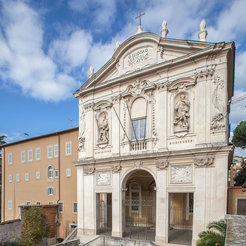
Ideas, Networks, Identities
The Collegio di Sant'Isidoro in Rome and its Architecture and Artistic Furnishings in the 17th Century
The Collegio di Sant'Isidoro was an important intellectual center in Rome during the 17th century, where scholars from a wide range of disciplines met to study and discuss current theological, philosophical and art-theoretical topics. The college, which was then on the outskirts of the urban area, on the Pincio Hill, was founded in 1621 by Spanish Discalced Franciscans, but then passed to a group of Irish Franciscans under the direction of Father Luke Wadding, as early as 1625.

Wadding was not only a brilliant theologian, but also a highly energetic college rector who, within a short period of time, raised extensive funds for the construction of a representative church, the establishment of a study center and the constitution of an important library. Over the following decades, Sant'Isidoro developed into a point of contact for numerous important personages, including the humanists Athanasius Kircher and Lucas Holstenius, the artists Carlo Maratti and Gian Lorenzo Bernini and the art theorist Giovanni Pietro Bellori. In the immediate vicinity of the college were the properties of influential Roman families such as the Ludovisi and the Barberini, who were also active patrons of Sant'Isidoro. The aim of the research project is to examine more closely the intellectual milieu of Sant'Isidoro. In particular, the focus is on the collective identities that flowed together within it – Franciscans, Irish Catholic, Immaculates, Scotists – and their visual self-representation in the artistic furnishings of the church and the adjoining Aula Maxima.
Publication
Il Collegio di Sant'Isidoro: laboratorio artistico e crocevia d'idee nella Roma del Seicento, ed. by Susanne Kubersky-Piredda, Rome 2019.
- Susanne Kubersky-Piredda, "Rapporti tra arte e identità collettive nel Collegio di Sant'Isidoro", pp. 9–22.
- Matteo Binasco, "Gli 'Ibernesi' e l'Urbe fra la seconda metà del Cinquecento ed i primi decenni del Seicento: un rapporto difficile", pp. 23–32.
- Mícheál Mac Craith OFM, "National Identity and Universal Theology: Aspects of the History and Art of St. Isidore's", pp. 33–56.
- Donatella Bellardini, Claudia Costacurta, "I luoghi del sapere. Genesi della biblioteca e dell'archivio del Collegio di Sant'Isidoro", pp. 57–76.
- Elisabeth Oy-Marra, "Giovan Pietro Bellori, Carlo Maratti, Gian Lorenzo Bernini and St. Isidore's: Localizing a Friendship", pp. 77–96.
- Alina Aggujaro, "Tra decoro e magnificenza. Sulla fabbrica del Collegio di Sant'Isidoro degli Irlandesi", pp. 97–128.
- Andrea Bacciolo, "L'Apparizione della Vergine dell'Almudena a Sant'Isidoro Agricola: l'invenzione di Andrea Sacchi e la causa immacolista", pp. 129–142.
- Stefan Albl, "Carlo Marattis Werke für Sant'Isidoro im künstlerischen und kulturellen Kontext ihrer Zeit", pp. 143–176.
- Giulia Spoltore, "Possibili modelli algardiani nella cappella Ludovisi di Carlo Maratt", pp. 175–194.
- Silvia Mattina, "Gian Domenico Cerrini e la cappella di Sant'Antonio", pp. 195–206.
- Andrea Spiriti, "Francescani, scotisti, immacolisti, irlandesi: l'Aula Maxima del collegio isidoriano come strategia iconografica", pp. 207–228.
- Antonella Filiani, "Il restauro degli affreschi di Emanuele da Como nell'Aula Maxima del Collegio di Sant'Isidoro a Roma", pp. 229–245.
